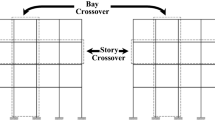Abstract
This study presents a new empirical model to estimate the base shear of plane steel structures subjected to earthquake load using a hybrid method integrating genetic programming (GP) and simulated annealing (SA), called GP/SA. The base shear of steel frames was formulated in terms of the number of bays, number of storey, soil type, and situation of braced or unbraced. A classical GP model was developed to benchmark the GP/SA model. The comprehensive database used for the development of the correlations was obtained from finite element analysis. A parametric analysis was carried out to evaluate the sensitivity of the base shear to the variation of the influencing parameters. The GP/SA and classical GP correlations provide a better prediction performance than the widely used UBC code and a neural network-based model found in the literature. The developed correlations may be used as quick checks on solutions developed by deterministic analyses.












Similar content being viewed by others
References
Caglar N, Pala M, Elmas M, Eryilmaz DM (2009) A new approach to determine the base shear of steel frame structures. J Construct Steel Res 65:188–195
UBC-97 (1997) Uniform building code. In: International conference of buildings official
El-Shafie A, Abdelazim T, Noureldin A (2010) Neural network modeling of time-dependent creep deformations in masonry structures. Neural Comput Appl 19:583–594
Chakraverty S, Gupta P, Sharma S (2010) Neural network-based simulation for response identification of two-storey shear building subject to earthquake motion. Neural Comput Appl 19:367–375
Koza J (1992) Genetic programming, on the programming of computers by means of natural selection. MIT Press, Cambridge
Banzhaf W, Nordin P, Keller R, Francone F (1998) Genetic programming—an introduction. On the automatic evolution of computer programs and its application. Dpunkt/Morgan Kaufmann, Heidelberg/San Francisco
Alavi AH, Ameri M, Gandomi AH, Mirzahosseini MR (2011) Formulation of flow number of asphalt mixes using a hybrid computational method. Constr Build Mater 25(3):1338–1355
Gandomi AH, Alavi AH, Sahab MG (2010) New formulation for compressive strength of CFRP confined concrete cylinders using linear genetic programming. Mater Struct 43(7):963–983
Metropolis N, Rosenbluth AW, Rosenbluth MN, Teller AH, Teller E (1953) Equation of state calculations by fast computing mechanics. J Chem Phys 21(6):1087–1092
Li J, Liu X (2010) Melt index prediction by RBF neural network optimized with an MPSO-SA hybrid algorithm. Neurocomputing 74(5):735–740
Zain AM, Haron H, Sharif S (2011) Estimation of the minimum machining performance in the abrasive waterjet machining using integrated ANN-SA, Exp Syst Appl. doi:10.1016/j.eswa.2011.01.019
Zhang Q, Fang J, Wang Z, Shi M (2011) Hybrid genetic simulated annealing algorithm with its application in vehicle routing problem with time windows. Adv Mater Res 148–149:395–398
Xie Q, Li LS, Liu JH (2010) Adaptive collaborative optimization based on GASA algorithm. Jisuanji Jicheng Zhizao Xitong/Comput Integr Manufac Syst 16(11):2410–2415
Vasant P (2010) Hybrid simulated annealing and genetic algorithms for industrial production management problems. Int J Comput Methods 7(2):279–297
Deschaine LM, Zafran FA, Patel JJ, Amick D, Pettit R, Francone FD, Nordin P, Dilkes E, Fausett LV (2000) Solving the unsolved using machine learning, data mining and knowledge discovery to model a complex production process. In: Proceedings of advanced technology simulation conference, Wasington, DC
Gandomi AH, Alavi AH, Sahab MG, Gandomi M, Safari Gorji M (2008) Empirical models for prediction of flexural resistance and initial stiffness of welded beam-column joints. 11th East Asia-Pacific conference on structural engineering & construction (EASEC-11), Taipei, Taiwan, Paper 320
Javadi AA, Rezania M (2009) Applications of artificial intelligence and data mining techniques in soil modeling. Geomech Eng 1(1):53–74
Torres RS, Falcão AX, Gonçalves MA, Papa JP, Zhang B, Fan W, Fox EA (2009) A genetic programming framework for content-based image retrieval. Pattern Recogn 42(2):283–292
Francone F (2004) Discipulus Lite™ owner’s manual, version 4.0. Register Machine Learning Technologies
Brameier M, Banzhaf W (2001) A comparison of linear genetic programming and neural networks in medical data mining. IEEE Trans Evol Comput 5(1):17–26
Gandomi AH, Alavi AH, Mousavi M, Tabatabaei SM (2011) A hybrid computational approach to derive new ground-motion attenuation models. Eng Appl Artif Intell 24(4):717–732
Frank IE, Todeschini R (1994) The data analysis handbook. Elsevier, Amsterdam
Johari A, Habibagahi G, Ghahramani A (2006) Prediction of soil–water characteristic curve using genetic programming. J Geotech Geoenviron ASCE 132(5):661–665
Silva S (2007) GPLAB, a genetic programming toolbox for MATLAB. http://www.gplab.sourceforge.net
Conrads M, Dolezal O, Francone FD, Nordin P (2004) Discipulus Lite-fast genetic programming based on AIM learning technology. Register Machine Learning Technologies Inc., Littleton
Smith GN (1986) Probability and statistics in civil engineering. Collins, London
Golbraikh A, Tropsha A (2002) Beware of q2. J Mole Graph Model 20:269–276
Roy PP, Roy K (2008) On some aspects of variable selection for partial least squares regression models. QSAR Comb Sci 27:302–313
Kraslawski A, Pedrycz W, Nyström L (1999) Fuzzy neural network as instance generator for case-based reasoning system: an example of selection of heat exchange equipment in mixing. Neural Comput Appl 8(2):106–113
Acknowledgments
The authors are thankful to Amir Hossein Alavi (Iran University of Science & Technology) for his support and stimulating discussions.
Author information
Authors and Affiliations
Corresponding author
Rights and permissions
About this article
Cite this article
Aminian, P., Javid, M.R., Asghari, A. et al. A robust predictive model for base shear of steel frame structures using a hybrid genetic programming and simulated annealing method. Neural Comput & Applic 20, 1321–1332 (2011). https://doi.org/10.1007/s00521-011-0689-0
Received:
Accepted:
Published:
Issue Date:
DOI: https://doi.org/10.1007/s00521-011-0689-0




